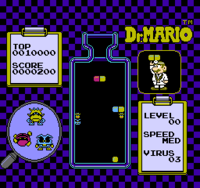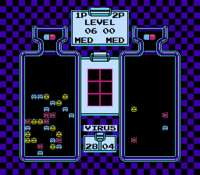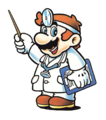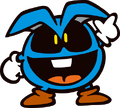Dr. Mario (game)
| It has been suggested that this page be split into the following: Dr. Mario (game), VS. Dr. Mario. (discuss) |
- This article is about the game. For other uses, see Dr. Mario (disambiguation).
Template:Infobox Dr. Mario (stylized as "D℞. MARIO" on the western logo) is an arcade-style puzzle video game created by Nintendo, and was released for the Nintendo Entertainment System and Game Boy in 1990. The gameplay is very similar to that of Tetris, although in Dr. Mario, the object is to line up pills to destroy viruses.
Story
The following text is taken directly from the instruction manual.
Hi everybody! I'm Mario. How's it going? Over the last few years, I've been involved in some pretty wild adventures. Now, believe it or not, I work in the virus research lab at the Mushroom Kingdom Hospital. Today I'm about to begin my research as usual.
"Dr. Mario, something terrible has happened!"
"What's wrong, nurse Toadstool?" "One of the experiments has gone out of control. The viruses are spreading quickly!"
"Oh No! We've got to do something! I have just developed a new vitamin that should be able to take care of it. I sure hope this stuff works!"
Dr. Mario works in a virus research lab at the Mushroom Kingdom Hospital, alongside Nurse Toadstool. When one of the experiments goes wrong, the hospital is flooded with tri-color viruses. Armed with Megavitamins–a medicine of his own invention–Dr. Mario sets out to neutralize the outbreak.
Gameplay
All the Dr. Mario games feature a large grid as the main game interface. This grid (in the shape of a large pill bottle) starts out partially filled with three types of viruses, Chill (blue), Fever (red), and Weird (yellow). The main objective of the game is to clear the grid of the viruses. This objective can be fulfilled with the help of multi-colored pills called Megavitamins. These pills are two-blocks wide and come in the same color as the viruses. Usually, they are sectioned off into two random colors, but occasionally contain only one random color. These pills are guided down the grid by using left and right on the Control Pad, and they can be pulled to the bottom of the screen more quickly by holding down on the Control Pad. They can be rotated clockwise by
and counter-clockwise by
. To eliminate a virus, four blocks of a color (pill or virus) must be piled up. The stack will then disappear. If a virus was contained in the stack, the virus will be eliminated as well.
If the stacks of pills or viruses reach the top of the grid, the player receives a Game Over.
Characters
Game modes
1-Player Game
When a 1-Player game is started, the player can choose one of 21 levels (from 0 to 20). The number of viruses at the beginning is equal to four times the level number plus four, all the way up to level 20 (although the level number can go up to 24 in the NES version, there will always be 84 viruses at the beginning of levels 20 and above[1]). The speed of the pills as they fall can also be selected: low, medium, or high. As the game level progresses, though, the speed will gradually increase.
2-Player Game
A 2-Player Vs. game mode is also available for selection. In this mode, two players battle to either clear their grid first, or cause their opponent to get a Game Over. The game ends after one of the players wins three rounds. The Level and Speed options are chosen independently by each player before the game begins.
During a two-player battle, whenever a row or column is cleared with one Megavitamin, a corresponding number (two, three, or the maximum, four) of randomized pill halves drops on to the opponent's grid. The player who is given the pill halves must wait for the random colors to drop onto their screen before they can drop a Megavitamin. As time passes, pills fall faster, just like in one-player mode.
For the Game Boy version, a Game Link cable is required to play the 2-player Vs. game mode. On the 3DS Virtual Console version, 2-player mode is not supported.
Reception
The Game Boy version of the game was placed 45th in the 100th issue of Nintendo Power's "100 best Nintendo games of all time" in 1997.[2] The NES version placed 69th in the 200th Issue of GameInformer's "Top 200 Games of All Times". The game placed 51st in IGN's Top 100 NES Games list.[3]
Reviews for the game were generally positive, although there has been some criticism from parents about the medicine in a children's game. ACE in particular was more negative, giving the Game Boy version 510/1000, criticizing the repetitive gameplay and uninspired graphics. They also stated that the game "reeks of plagarism", stating that it was worse than the original games it was modeled after.[4] GameRankings gave the game 69.25%, while review aggregator Metacritic gave it a 66 out of 100 based on 10 reviews.
Remakes and ports
VS. Dr. Mario
It has been requested that more images be uploaded for this section. Remove this notice only after the additional image(s) have been added. Reason: title screen and gameplay
The game was later released on the VS. System under the name VS. Dr. Mario. This version drops the Slow mode and features a less generous scoring system. In the NES version, the first virus killed by a vitamin yields 200 points (on Normal mode), the second 400, the third 800, the fourth 1600, so each virus is worth twice as much as the last. In the VS. version, the first virus is worth 200, then 400, then 600, then 800, so a virus is worth only 200 points more, and not twice as many points, as the previous virus.
Satellaview
A slightly altered version of Dr. Mario known as Dr. Mario BS Version 「Dr.マリオBS版」 was broadcast for the Satellaview system between March 1997 and June 2000. It has the same graphics and music that was used in the remake from Tetris & Dr. Mario which was not released in Japan. It should also be mentioned that the complete game is still in the ROM, just locked out.[5]
List of re-releases and ports
- Dr. Mario was ported into the Nintendo PlayChoice-10 arcade machines in North America.
- In 1994, Nintendo released the remake for SNES, as a part of the Tetris & Dr. Mario cartridge.
- In 2004, Nintendo re-released the original NES version for the Game Boy Advance, as part of the Classic NES Series.
- In 2005, Nintendo again released Dr. Mario for Game Boy Advance, but this time as an enhanced remake in Dr. Mario & Puzzle League.
- On March 22, 2012, the Game Boy version was released on the Nintendo 3DS's Virtual Console in PAL regions and it was released in Japan and North America on October 2nd and 3rd respectively later that year.
- A trial version of the Game Boy game appears as a unlockable Masterpiece in Super Smash Bros. for Wii U.
- Dr. Mario is one of the games that appear in NES Remix 2 and Ultimate NES Remix. It is the final challenge in Championship Mode.
- A trial version of the NES game appears as a "highlight" in amiibo tap: Nintendo's Greatest Bits.
- The NES and Famicom version of Dr. Mario is one of the 30 games included in the NES Classic Edition and Nintendo Classic Mini: Family Computer, respectively.
- Dr. Mario was made available as one of the 20 NES titles at Nintendo Entertainment System - Nintendo Switch Online's launch in September 2018, and can be played competitively with other players online.[6] A special edition titled Dr. Mario: The UFO cover-up. that starts the player at level 20 and Hi speed was also added on December 12, 2018.
Microgame
WarioWare, Inc.: Mega Microgame$! featured a microgame version of Dr. Mario. There is also an unlockable mini game version entitled Dr. Wario.
Another microgame based on this game appeared in WarioWare Gold.
Development
Dr. Mario was originally under the title "Virus", which had similar gameplay, but the goal was to cure viruses in a sick animal. What appears to be Nurse Toadstool is also visible in the game.[7]
Gallery
- For this subject's image gallery, see Gallery:Dr. Mario (game).
Media
| It has been suggested that audio and/or video file(s) related to this section be uploaded. Reason: NES and GB Please upload all related music, sound effects, voice clips, or any videos for this section. See the help page for information on how to get started. |
NES
| File info 0:30 |
Staff
- Main article: List of Dr. Mario staff
Names in other languages
| Language | Name | Meaning |
|---|---|---|
| Japanese | ドクターマリオ Dokutā Mario |
Dr. MARIO |
| Chinese (simplified) | 马力欧医生 Mǎlì'ōu Yīshēng |
Dr. Mario |
| Chinese (traditional) | 瑪利歐醫生 Mǎlì'ōu Yīshēng |
Dr. Mario |
Dr. Mario: The UFO cover-up.
| Language | Name | Meaning |
|---|---|---|
| Japanese | ドクターマリオ 知る人ぞ知るUFO直前バージョン Dokutā Mario Shiru Hitozo Shiru Yūfō Chokuzen Bājon |
Dr. MARIO: "Just Before the UFO Known to the Few" Version |
References
- ^ Dr. Mario AI Defeats Level 24 and Beyond
- ^ http://www.gamekult.com/communaute/forum/voirmessage.html?foid=13000909, retrieved 5-31-2009
- ^ [1]
- ^ [2]
- ^ TCRF - Tetris & Dr. Mario#BS and NP Dr. Mario
- ^ Nintendo Entertainment System – Nintendo Switch Online. Nintendo. Retrieved May 8, 2018.
- ^ https://twitter.com/VGArtAndTidbits/status/808922353451302912
External links
- Nintendo UK Game Boy Advance site
- Japanese website (Game Boy)
- Japanese website (Super Famicom Nintendo Power)
| Game Boy games | |
|---|---|
| Super Mario franchise | Alleyway (1989) • Baseball (1989) • Super Mario Land (1989) • Golf (1989) • Dr. Mario (1990) • Super Mario Land 2: 6 Golden Coins (1992) • Donkey Kong (1994) • Mario's Picross (1995) • Picross 2 (1996) |
| Donkey Kong franchise | Donkey Kong (1994) • Donkey Kong Land (1995) • Donkey Kong Land 2 (1996) • Donkey Kong Land III (1997) |
| Yoshi franchise | Yoshi (1991) • Yoshi's Cookie (1992) • Tetris Attack (1996) |
| Wario franchise | Wario Land: Super Mario Land 3 (1994) • Wario Blast: Featuring Bomberman! (1994) • Wario Land II (1998) |
| Miscellaneous | Tetris (1989) • The Legend of Zelda: Link's Awakening (1993) • Game & Watch Gallery (1997) • Game & Watch Gallery 2 (1997) |






